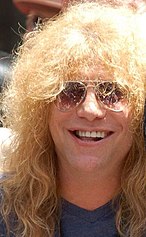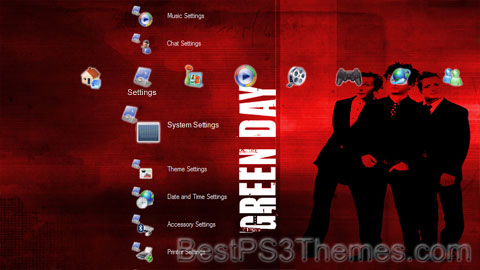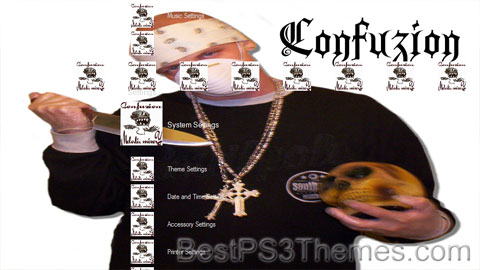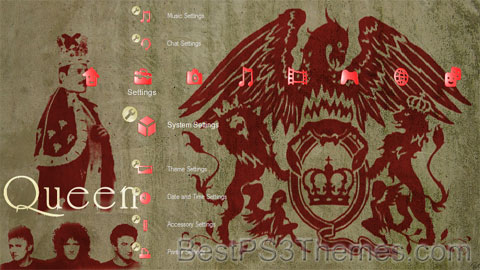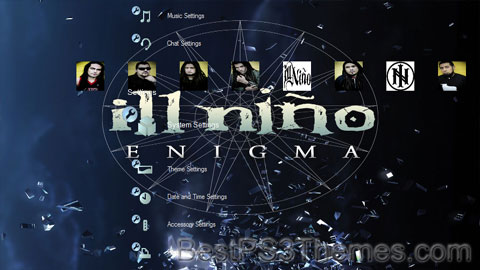Avril Lavigne theme by Ali4Chris
Download: AvrilLavigne_3.p3t
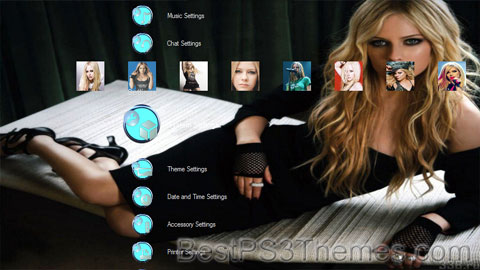
(8 backgrounds)
Avril Lavigne | |
|---|---|
 Lavigne in 2019 | |
| Born | Avril Ramona Lavigne September 27, 1984 Belleville, Ontario, Canada |
| Citizenship |
|
| Occupations |
|
| Years active | 1999–present |
| Works | |
| Spouses | |
| Relatives | Ryota Kohama (brother-in-law) |
| Awards | Full list |
| Musical career | |
| Genres | |
| Instruments |
|
| Labels | |
TikTok information | |
| Page | |
| Followers | 5.7 million |
| Likes | 39.2 million |
Last updated: June 28, 2024 | |
| Website | avrillavigne |
| Signature | |
 | |
Avril Ramona Lavigne CM[1] (/ˈævrɪl ləˈviːn/ AV-ril lə-VEEN, French: [avʁil ʁamɔna laviɲ]; born September 27, 1984) is a Canadian singer-songwriter. She is considered a key musician in the development of pop-punk music, as she paved the way for female-driven, punk-influenced pop music in the early 2000s.[2][3] Her accolades include eight Grammy Award nominations.
At age 16, Lavigne signed a two-album recording contract with Arista Records. Her debut studio album, Let Go (2002), is the best-selling album of the 21st century by a Canadian artist. It yielded the successful singles "Complicated" and "Sk8er Boi", which emphasized a skate punk persona and earned her the title "Pop-Punk Queen" from music publications.[4][5] Her second studio album, Under My Skin (2004), became Lavigne's first album to reach the top of the Billboard 200 chart in the United States, going on to sell 10 million copies worldwide.
Lavigne's third studio album, The Best Damn Thing (2007), reached number one in seven countries worldwide and saw the international success of its lead single "Girlfriend", which became her first single to reach the top of the Billboard Hot 100 in the United States. Her next two studio albums, Goodbye Lullaby (2011) and Avril Lavigne (2013), saw continued commercial success and were both certified gold in Canada, the United States, and other territories.[6][7][8] After releasing her sixth studio album, Head Above Water (2019), she returned to her punk roots with her seventh studio album, Love Sux (2022).[9]
Early life[edit]
Avril Ramona Lavigne was born on September 27, 1984, in Belleville, Ontario. She was named Avril (the French word for April) by her father.[10] He and Lavigne's mother recognized their child's vocal abilities when she was two years old and sang "Jesus Loves Me" on the way home from church.[11] Lavigne has an older brother named Matthew and a younger sister named Michelle,[12] both of whom teased her when she sang. "My brother used to knock on the wall because I used to sing myself to sleep and he thought it was really annoying."[11] She is the sister-in-law of Japanese band One OK Rock bassist Ryota Kohama.[13] Lavigne's paternal grandfather Maurice Yves Lavigne was born in Saint-Jérôme, Quebec.[14] A member of the Royal Canadian Air Force, he married Lucie Dzierzbicki, a French native of Morhange in 1953. Their son, Jean-Claude Lavigne, was born in 1954 at RCAF Station Grostenquin near Grostenquin, Lorraine.[15] When Jean-Claude was a child, the family moved to Ontario, and in 1975, he married Judith-Rosanne "Judy" Loshaw.[16][17]
When Lavigne was 5, the family moved to Napanee (now incorporated as Greater Napanee),[18] a town with a population of approximately 5,000 at the time.[19][20][21] Also when she was 5, she was diagnosed with ADHD, which caused her problems during her school years.[22]
To support her musical interests, her father bought her a microphone, a drum kit, a keyboard, and several guitars, and converted their basement into a studio. Her father often played bass at the church the family attended, the Third Day Worship Centre in Kingston. When Lavigne was 14 years old, her parents took her to karaoke sessions.[23]
Lavigne performed at country fairs, singing songs by Garth Brooks, the Chicks, and Shania Twain, and began writing her own songs. Her first song was called "Can't Stop Thinking About You", about a teenage crush, which she described as "cheesy cute".[24]
Lavigne also played hockey during high school and won MVP twice as a right winger in a boys league.[25]
Career[edit]
1999–2001: Career beginnings[edit]
In 1999, Lavigne won a radio contest to perform with Canadian singer Shania Twain at the Corel Centre in Ottawa, before an audience of 20,000 people.[26][18][19] Twain and Lavigne sang Twain's song, "What Made You Say That",[18] and Lavigne told Twain that she aspired to be "a famous singer".[19] During a performance with the Lennox Community Theatre, Lavigne was spotted by local folksinger Stephen Medd. He invited her to contribute vocals on his song, "Touch the Sky", for his 1999 album, Quinte Spirit. She later sang on "Temple of Life" and "Two Rivers" for his follow-up album, My Window to You, in 2000.
In December 1999, Lavigne was discovered by her first professional manager, Cliff Fabri, while singing country covers at a Chapters bookstore in Kingston.[18][19] Fabri sent out VHS tapes of Lavigne's home performances to several industry prospects, and Lavigne was visited by several executives.[27] Mark Jowett, co-founder of a Canadian management firm, Nettwerk, received a copy of Lavigne's karaoke performances recorded in her parents' basement.[28] Jowett arranged for Lavigne to work with producer Peter Zizzo during the summer of 2000 in New York, where she wrote the song "Why". Lavigne was noticed by Arista Records during a trip to New York.[27]
In November 2000,[20] Ken Krongard, an A&R representative, invited Antonio "L.A." Reid, then head of Arista Records, to Zizzo's Manhattan studio to hear Lavigne sing. Her 15-minute audition "so impressed" Reid that he immediately signed her to Arista with a deal worth $1.25 million for two albums and an extra $900,000 for a publishing advance.[21][18] By this time, Lavigne had found that she fit in naturally with her hometown high school's skater clique, an image that carried through to her first album, but although she enjoyed skateboarding, school left her feeling insecure. Having signed a record deal, and with support from her parents, she left school to focus on her music career.[20][29][24] Lavigne's band, which were mostly the members of Closet Monster, was chosen by Nettwerk, as they wanted young performers who were up and coming from the Canadian punk rock scene who would fit with Lavigne's personality.[30]
2002–2003: Let Go[edit]

Reid gave A&R Joshua Sarubin the responsibility of overseeing Lavigne's development and the recording of her debut album. They spent several months in New York working with different co-writers, trying to forge an individual sound for her. Sarubin told HitQuarters that they initially struggled; although early collaborations with songwriter-producers including Sabelle Breer, Curt Frasca and Peter Zizzo resulted in some good songs, they did not match her or her voice. It was only when Lavigne went to Los Angeles in May 2001 and created two songs with the Matrix production team—including "Complicated", later released as her debut single—that the record company felt she had made a major breakthrough. Lavigne worked further with the Matrix and also with singer-songwriter Clif Magness. Recording of Lavigne's debut album, Let Go, finished in January 2002.[31]
Lavigne released Let Go in June 2002 in the US, where it reached number two on the Billboard 200 albums chart. It peaked at number one in Australia, Canada, and the UK—this made Lavigne, at 17 years old, the youngest female soloist to have a number-one album on the UK Albums Chart at that time.[32] By the end of 2002, the album was certified four-times Platinum by the RIAA, making her the bestselling female artist of 2002 and Let Go the top-selling debut of the year.[33] By May 2003, Let Go had accumulated over 1 million sales in Canada, receiving a diamond certification from the Canadian Recording Industry Association.[34] By 2009, the album had sold over 16 million units worldwide.[35] By March 2018, the RIAA certified the album seven-times Platinum, denoting shipments of over seven million units in the US.[36]
Lavigne's debut single, "Complicated", peaked at number one in Australia and number two in the US. "Complicated" was one of the bestselling Canadian singles of 2002, and one of the decade's biggest hits in the US,[37] where subsequent singles "Sk8er Boi" and "I'm with You" reached the top ten.[38] With these three singles, Lavigne became the second artist in history to have three top-ten songs from a debut album on Billboard's Mainstream Top 40 chart.[39] Lavigne was named Best New Artist (for "Complicated") at the 2002 MTV Video Music Awards,[40] won four Juno Awards in 2003 out of six nominations,[41] received a World Music Award for "World's Bestselling Canadian Singer", and was nominated for eight Grammy Awards, including Best New Artist and Song of the Year for "Complicated".[42]
In 2002, Lavigne made a cameo appearance in the music video for "Hundred Million" by the pop punk band Treble Charger.[43] In March 2003, Lavigne posed for the cover of Rolling Stone magazine,[16] and in May she performed "Fuel" during MTV's Icon tribute to Metallica.[44][45] During her first headlining tour, the Try to Shut Me Up Tour, Lavigne covered Green Day's "Basket Case".[46]
2004–2005: Under My Skin[edit]

Lavigne's second studio album, Under My Skin, was released in May 2004 and debuted at number one in Australia, Canada, Japan, the UK, and the US.[47] The album was certified five-times Platinum in Canada[48] and has sold 10 million copies,[49] including 3.2 million in the US.[50] Lavigne wrote most of the album's tracks with Canadian singer-songwriter Chantal Kreviazuk, and Kreviazuk's husband, Our Lady Peace front man Raine Maida, co-produced the album with Butch Walker and Don Gilmore. Lavigne said that Under My Skin proved her credentials as a songwriter, saying that "each song comes from a personal experience of mine, and there are so much [sic] emotions in those songs".[51] "Don't Tell Me", the lead single off the album, reached the top five in the UK and Canada and the top ten in Australia. "My Happy Ending", the album's second single, was a top five hit in the UK and Australia. In the US, it was a top ten entry on the Billboard Hot 100 and became a number-one pop radio hit. The third single, "Nobody's Home", did not manage to make the top 40 in the US and performed moderately elsewhere.
During early 2004 Lavigne went on the 'Live and By Surprise' acoustic mall tour in the US and Canada to promote Under My Skin, accompanied by her guitarist Evan Taubenfeld. In September 2004, Lavigne embarked on her first world tour, the year-long Bonez Tour. Lavigne won two World Music Awards in 2004, for 'World's Best Pop/Rock Artist' and 'World's Bestselling Canadian Artist' and won three Juno Awards from five nominations in 2005, including 'Artist of the Year'.[52] She also won in the category of 'Favorite Female Singer' at the eighteenth annual Nickelodeon Kids' Choice Awards.[53]
Lavigne co-wrote the song "Breakaway", which was recorded by Kelly Clarkson for the soundtrack to the 2004 film The Princess Diaries 2: Royal Engagement.[54] "Breakaway" was released as a single in mid 2004 and subsequently included as the title track on Clarkson's second album, Breakaway. Lavigne performed the Goo Goo Dolls song "Iris" with the band's lead singer John Rzeznik at Fashion Rocks in September 2004,[55] and she posed for the cover of Maxim in October 2004.[56] She recorded the theme song for The SpongeBob SquarePants Movie (released in November 2004) with producer Butch Walker.[57]
2006–2011: The Best Damn Thing and Goodbye Lullaby[edit]
In February 2006, Lavigne represented Canada at the closing ceremony of the 2006 Winter Olympics.[58] Fox Entertainment Group approached Lavigne to write a song for the soundtrack to the 2006 fantasy-adventure film Eragon; her contribution, "Keep Holding On", was released as a single to promote the film and its soundtrack.[59][60][61]

Lavigne's third album, The Best Damn Thing, was released in April 2007 and debuted at number one on the U.S. Billboard 200,[62] and subsequently achieved Platinum status in Canada.[48] The album sold more than 2 million copies in the US.[36] Its lead single, "Girlfriend", became Lavigne's first number-one single on the U.S. Billboard Hot 100 and one of the decade's biggest singles.[62][63] The single also peaked at number one in Australia, Canada, and Japan, and reached number two in the UK and France. As well as English, "Girlfriend" was recorded in Spanish, French, Italian, Portuguese, German, Japanese, and Mandarin. The International Federation of the Phonographic Industry ranked "Girlfriend" as the most-downloaded track worldwide in 2007, selling 7.3 million copies, including the versions recorded in eight different languages.[64][65] "When You're Gone", the album's second single, reached the top five in Australia and the United Kingdom, the top ten in Canada, and the top forty in the US. "Hot" was the third single and charted only at number 95 in the US, although it reached the top 10 in Canada and the top 20 in Australia.
Lavigne won two World Music Awards in 2007, for 'World's Bestselling Canadian Artist' and 'World's Best Pop/Rock Female Artist'. She won her first two MTV Europe Music Awards, received a Teen Choice Award for 'Best Summer Single', and was nominated for five Juno Awards.[52] In December 2007, Lavigne was ranked number eight in Forbes magazine's list of 'Top 20 Earners Under 25', with annual earnings of $12 million.[66] In March 2008, Lavigne undertook a world tour, The Best Damn World Tour, and appeared on the cover of Maxim for the second time.[67] In mid-August, Malaysia's Islamic opposition party, the Pan-Malaysian Islamic Party, attempted to ban Lavigne's tour show in Kuala Lumpur, judging her stage moves "too sexy". It was thought that her concert on August 29 would promote wrong values ahead of Malaysia's Independence Day on August 31.[68] On August 21, 2008, MTV reported that the concert had been approved by the Malaysian government.[69]
In January 2010, Lavigne worked with Disney to create clothing designs inspired by Tim Burton's feature film Alice in Wonderland. She recorded a song for its soundtrack, "Alice", which was played over the end credits and included on the soundtrack album Almost Alice.[70][71][72] In February, Lavigne performed at the Vancouver 2010 Winter Olympics closing ceremony.[73] Lavigne's song "I'm with You" was sampled by Rihanna on the track "Cheers (Drink to That)", which is featured on Rihanna's fifth studio album, Loud (2010).[74][75] "Cheers (Drink to That)" was released as a single the following year, and Lavigne appeared in its music video.[76] In December 2010, American singer Miranda Cosgrove released "Dancing Crazy", a song written by Lavigne, Max Martin and Shellback. It was also produced by Martin.[77]
Lavigne began recording for her fourth studio album, Goodbye Lullaby, in her home studio in November 2008. Its opening track, "Black Star", was written to help promote her first fragrance of the same name.[78][79] Lavigne described the album as being about her life experiences rather than focusing on relationships, and its style as less pop rock than her previous material, reflecting her age.[79][80] The release date for Goodbye Lullaby was delayed several times, which Lavigne said was because of her label.[81][82] Goodbye Lullaby was released in March 2011,[83][80] and its lead single, "What the Hell", premiered in December 2010, ahead of the album's release.[83] Goodbye Lullaby received Juno Award nominations for Album of the Year and Pop Album of the Year.[52] By March 2018, Goodbye Lullaby sold more than 500,000 copies in the US, and it was certified Gold by the RIAA.[36]
2012–2017: Self-titled album[edit]

Three months after the release of Goodbye Lullaby, Lavigne announced that work on her fifth studio album had already begun, describing it as the musical opposite of Goodbye Lullaby[84] and "pop and more fun again".
Slipknot1-jk
Slipknot1-jk theme by toppdogg
Download: Slipknot1-jk.p3t
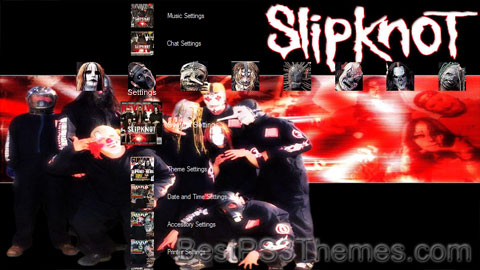
(15 backgrounds)
P3T Unpacker v0.12
Copyright (c) 2007. Anoop Menon
This program unpacks Playstation 3 Theme files (.p3t) so that you can touch-up an existing theme to your likings or use a certain wallpaper from it (as many themes have multiple). But remember, if you use content from another theme and release it, be sure to give credit!
Download for Windows: p3textractor.zip
Instructions:
Download p3textractor.zip from above. Extract the files to a folder with a program such as WinZip or WinRAR. Now there are multiple ways to extract the theme.
The first way is to simply open the p3t file with p3textractor.exe. If you don’t know how to do this, right click the p3t file and select Open With. Alternatively, open the p3t file and it will ask you to select a program to open with. Click Browse and find p3textractor.exe from where you previously extracted it to. It will open CMD and extract the theme to extracted.[filename]. After that, all you need to do for any future p3t files is open them and it will extract.
The second way is very simple. Just drag the p3t file to p3textractor.exe. It will open CMD and extract the theme to extracted.[filename].
For the third way, first put the p3t file you want to extract into the same folder as p3textractor.exe. Open CMD and browse to the folder with p3extractor.exe. Enter the following:
p3textractor filename.p3t [destination path]Replace filename with the name of the p3t file, and replace [destination path] with the name of the folder you want the files to be extracted to. A destination path is not required. By default it will extract to extracted.filename.
Guns N’ Roses
Guns N’ Roses theme by Tiiger
Download: GunsNRoses.p3t
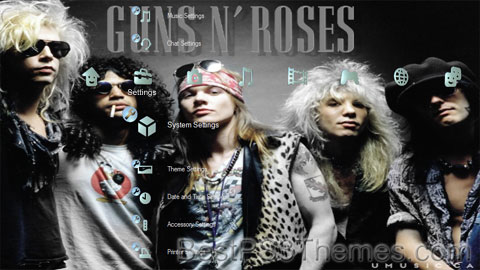
(1 background)
Guns N' Roses | |
|---|---|
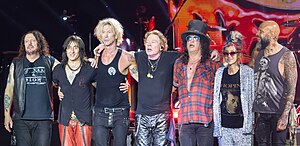 Guns N' Roses at Glastonbury Festival 2023. From left to right: Dizzy Reed, Richard Fortus, Duff McKagan, Axl Rose, Slash, Melissa Reese and Frank Ferrer | |
| Background information | |
| Also known as | GNR |
| Origin | Los Angeles, California, U.S. |
| Genres | |
| Discography | Guns N' Roses discography |
| Years active | 1985–present |
| Labels | |
| Spinoffs | |
| Spinoff of | |
| Members | |
| Past members | |
| Website | gunsnroses |
Guns N' Roses[a] is an American hard rock band from Los Angeles, California, formed in March 1985 when local bands Hollywood Rose and L.A. Guns merged. When they signed to Geffen Records in 1986, the band's "classic lineup" consisted of vocalist Axl Rose, lead guitarist Slash, rhythm guitarist Izzy Stradlin, bassist Duff McKagan, and drummer Steven Adler. The current lineup consists of Rose, Slash, McKagan, guitarist Richard Fortus, drummer Frank Ferrer and keyboardists Dizzy Reed and Melissa Reese.
Guns N' Roses heavily toured the West Coast club circuit during their early years before embarking on the Appetite for Destruction Tour. Their debut album Appetite for Destruction (1987) failed to gain traction, debuting at number 182 on the Billboard 200, until a year after its release when a grassroots campaign for the "Welcome to the Jungle" music video brought the band mainstream popularity. "Welcome to the Jungle" and "Paradise City" both became top 10 singles, with "Sweet Child o' Mine" becoming the band's only single to reach number one on the Billboard Hot 100. The album has sold approximately 30 million copies worldwide, including 18 million units in the United States, making it the country's best-selling debut album and eleventh-best-selling album. With their stylistic mix of punk rock, blues rock and heavy metal, the band helped move mainstream rock away from the glam metal era of the mid-late 1980s. In addition, they are credited with revitalizing power ballads in rock. Their next studio album, G N' R Lies (1988) combined an early EP, Live ?!*@ Like a Suicide (1986), with new acoustic songs and reached number two on the Billboard 200, sold ten million copies worldwide (including five million in the U.S.), and included the top 5 hit "Patience" and the controversial "One in a Million". Adler was fired due to his drug addiction in 1990 and was replaced by Matt Sorum.
Use Your Illusion I and Use Your Illusion II, recorded and released simultaneously in 1991, debuted at number two and number one on the Billboard 200 respectively and have sold a combined 35 million copies worldwide (including 14 million units in the U.S.). The Illusion albums included the lead single "You Could Be Mine", covers of "Live and Let Die" and "Knockin' on Heaven's Door", and a trilogy of ballads ("Don't Cry", "November Rain", and "Estranged"), which featured notably high-budget music videos. The records were supported by the Use Your Illusion Tour, a world tour that lasted from 1991 to 1993. Stradlin abruptly left the band near the beginning of the tour in 1991, replaced by Gilby Clarke. The punk covers album "The Spaghetti Incident?" (1993) was the last studio album to feature Stradlin and Sorum, only to feature Clarke, and the last for Slash and McKagan before their initial departure. While mostly well received, it was the band's worst-selling studio album to date and was not supported by a tour.
Work on a follow-up album stalled due to creative differences and personal conflicts between Rose and other members; Slash and McKagan left the band while Clarke and Sorum were fired. In 1998 Rose, Reed, guitarists Paul Tobias and Robin Finck, bassist Tommy Stinson, drummer Josh Freese and multi-instrumentalist Chris Pitman started writing and recording new songs. Guitarists Buckethead, Bumblefoot and Fortus, and drummers Brain and Ferrer all contributed as the band's lineup changed. Their upcoming sixth studio album, Chinese Democracy (2008), was promoted with the expansive Chinese Democracy Tour (2001-2011). With Rose failing to deliver the album on schedule, Geffen released Greatest Hits (2004), which became the 8th longest charting album in the history of the Billboard 200, reaching 631 weeks by July 2023.[1] The long-awaited Chinese Democracy was released in November 2008, featuring the title track as the lead single. At an estimated $14 million in production costs, it is the most expensive rock album in history. It debuted at number three on the Billboard 200 with a generally positive critical reception. Slash and McKagan rejoined the band in 2016 for the quasi-reunion Not in This Lifetime... Tour, which became one of the highest grossing concert tours of all-time, grossing over $584 million by its conclusion in 2019.
In their early years, the band's hedonism and rebelliousness drew comparisons to the early Rolling Stones and earned them the nickname "the most dangerous band in the world". Significant controversy followed the band due to late show starts and riots (notably the 1991 Riverport riot), lyrics perceived as problematic, Rose's outspoken persona, several other members' drug and alcohol abuse issues, lawsuits, and public feuds with other artists. Several members of the band are considered some of the best in their fields, with Rose considered one of the best vocalists, Slash as one of the best guitarists and McKagan as one of the best bassists by various publications. Guns N' Roses (Rose, Stradlin, McKagan, Slash, Adler, Sorum and Reed) were inducted into the Rock and Roll Hall of Fame in 2012. Guns N' Roses have sold more than 100 million records worldwide, including 45 million in the United States, making them one of the best-selling bands in history.
History[edit]
Formation (1985–1986)[edit]

In 1984, Hollywood Rose member Izzy Stradlin was living with L.A. Guns member Tracii Guns.[2][3] When L.A. Guns needed a new vocalist, Stradlin suggested Hollywood Rose singer Axl Rose.[2] This led to Guns N' Roses being formed in March 1985 by Rose, rhythm guitarist Stradlin, along with L.A. Guns founders lead guitarist Guns, drummer Rob Gardner, and bassist Ole Beich.[4] Guns recalled the formation of the band in a 2019 interview, stating: "Axl got into an argument with our manager and our manager fired Axl but we all lived together so it was all really weird. So, that same night he got fired we started Guns N' Roses and I called Izzy the next day and said 'Hey, we are gonna start this new band called Guns N' Roses, do you want in?' It was as simple as that, no paint or cocaine involved."[5] The band coined its name by combining the names of both previous groups; initially it was the name of a label they were going to release music on.[5] Rejected names for the band included "Heads of Amazon" and "AIDS".[6]
After the band's first two rehearsals, Beich was fired and replaced by Duff McKagan.[7][8] The first rehearsal with McKagan was recorded and three songs from it ("Don't Cry", "Think About You" and "Anything Goes") were played during the band's first radio interview, aired two days before their first ever show at the Troubadour on March 26, 1985.[b][9][10][11][12] Around this time, the band planned to release an EP with the three aforementioned songs and a cover of "Heartbreak Hotel".[11] However, Guns left the band after an argument with Rose, and plans for the release fell through.[3] Guns was replaced by a former Hollywood Rose member, Slash.[2] Gardner, the last remaining L.A. Guns member to remain in the band, quit soon after.[13] Steven Adler, another former Hollywood Rose member, filled Gardner's spot.[14][15][c]
We had a singer (Mike Jagosz) that our manager didn't like, so we fired him. So then I asked Axl to join L.A. Guns and he was in the band for about six, seven months. The same manager ended up hating Axl and he wanted to fire him. We're all living together at this point and Axl and I sat down and went 'What are we going to do?' So we both said 'Fuck that', and came up with the name Guns N' Roses, which was going to be just a record label that we'd put singles out on.
—Original guitarist Tracii Guns[2]
The band's "classic" lineup was finalized on June 4, 1985, when Adler and Slash officially joined.[17] After two days of rehearsals, the band played their first show with the lineup on June 6, 1985.[17][18] Two days later, the band embarked on a short, disorganized tour of the West Coast, from Sacramento, California, to McKagan's hometown of Seattle, Washington.[19][20] The band drove in a separate van and had to abandon their gear when both vans broke down on the way to Seattle, forcing them to hitch-hike up the coast and back home to LA with only their guitars.[21][22] The so-called "Hell Tour" settled the band's first stable lineup, with McKagan later commenting, "This trip had set a new benchmark for what we were capable of, what we could and would put ourselves through to achieve our goals as a band."[19] The band then took up residence at a house and rehearsal space dubbed "The Hell House".[d]
Through the band's increasing presence on the Hollywood club scene – playing famed bars such as The Troubadour and The Roxy – Guns N' Roses drew the attention of major record labels.[6][25] The group signed with Geffen Records in March 1986, receiving a $75,000 ($208,470 in current dollar terms) advance.[6] They had turned down an offer from Chrysalis Records that was nearly double Geffen's, due to Chrysalis wanting to change the band's image and sound and Geffen offering full artistic freedom.[26][27]
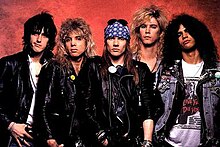
In December of that year, the group released the four-song EP Live ?!*@ Like a Suicide, designed to keep interest in the band alive while the group withdrew from the club scene to work in the studio.[28][29] The EP release was designed to sooth over the label, who felt the band did not have enough songs to record an album.[30] The EP contained covers of Rose Tattoo's "Nice Boys" and Aerosmith's "Mama Kin", along with two original compositions: the punk-influenced "Reckless Life" and the classic rock-inspired "Move to the City".[31] Although billed as a live recording, the four songs were taken from the band's demo tapes and overdubbed with crowd noise.[31] Live ?!*@ Like a Suicide was released on the Geffen subsidiary Uzi Suicide, with production limited to 10,000 vinyl copies.[32]
Seeking to record their debut album, producer Spencer Proffer was hired to record "Nightrain" and "Sweet Child o' Mine" to test his chemistry with the band.[33] The band eventually recorded 9 songs during these sessions, including "Heartbreak Hotel", "Don't Cry", "Welcome to the Jungle" and "Shadow of Your Love".[33] The band then recorded demos with Nazareth guitarist Manny Charlton.[33][e] Paul Stanley of KISS was considered as producer, but he was rejected after he wanted to change Adler's drum set more than Adler wanted.[33][f] Robert John "Mutt" Lange and Tom Werman were also considered, but the label did not want to spend the extra money on a famous producer.[33][36] Ultimately, Mike Clink (who had produced several Triumph records) was chosen,[37] and the group recorded "Shadow of Your Love" first with Clink as a test.[33]
After some weeks of rehearsal, the band entered Daryl Dragon's Rumbo Recorders in January 1987 to record their debut album.[33] Two weeks were spent recording basic tracks, with a month of overdubs.[38] The drums were done in six days, but Rose's vocals took much longer as he insisted on doing them one line at a time.[39]
Breakthrough and mass popularity (1987–1989)[edit]
Appetite for Destruction[edit]
Guns N' Roses' debut album Appetite for Destruction was released July 21, 1987.[40] The album underwent an artwork change after the original cover design by Robert Williams, which depicted a surrealist scene in which a dagger-toothed monster vengefully attacks a robot rapist, was deemed too controversial.[41][42][43] The band stated the original artwork was "a symbolic social statement, with the robot representing the industrial system that's raping and polluting our environment".[41] The revised cover was done by Andy Engell, based on a design by tattoo artist Bill White Jr., who had designed the artwork for a tattoo Rose had acquired the previous year.[44] The artwork featured each of the five band members' skulls layered on a cross.[41]
The band's first single was "It's So Easy", released on June 15, 1987, in the UK only, where it reached number eighty-four on the UK Singles Chart.[45][46] In the U.S., "Welcome to the Jungle" was issued as the album's first single in October, with an accompanying music video.[47]
Initially, the album and single lingered for almost a year without performing well, but when Geffen founder David Geffen was asked to lend support to the band, he obliged, personally convincing MTV executives to play "Welcome to the Jungle" during the network's after-hours rotation.[48][49] Even though the video was initially only played once at 4 a.m. on a Sunday, heavy metal and hard rock fans took notice and soon began requesting the video and song en masse.[50] The song, written in Seattle, was about Los Angeles. The music video took place in New York. According to Rose, the inspiration for the lyrics came from an encounter he and a friend had with a homeless man while they were coming out of a bus into New York.[51] Trying to put a scare into the young runaways, the man yelled at them, "You know where you are? You're in the jungle baby; you're gonna die!"[51][52] The song was featured in the 1988 Dirty Harry film The Dead Pool, starring Clint Eastwood, and members of the band had a cameo appearance in the film.[53][54]
"Sweet Child o' Mine" was the album's second U.S. single, a love song co-written by Rose as a poem for his then-girlfriend Erin Everly, daughter of Don Everly of the Everly Brothers.[55][56][57] Due to the growing grassroots success of the band and the cross-gender appeal of the song, "Sweet Child o' Mine" and its accompanying music video received heavy airplay on both radio and MTV, becoming a huge hit during the summer of 1988 and reaching the top of the charts in the U.S.[56] Slash later commented, "I hated that song with a huge passion for the longest time, and it turned out to be our hugest hit, so it goes to show what I know."[55] The song was released in Japan as part of the EP Live from the Jungle, which also featured a selection of live recordings from the band's June 1987 dates at London's The Marquee, the group's first shows outside the United States.[58][59] The song is the highest charting Guns N' Roses song, and is the band's only song to reach number one on the Billboard Hot 100.[60]
After the success of "Sweet Child o' Mine", "Welcome to the Jungle" was re-issued as a single and reached No. 7 in the U.S. By the time "Paradise City" and its video reached the airwaves, peaking at No. 5 in the U.S., Appetite for Destruction had reached No. 1 on the Billboard 200.[61] To date, the album has sold in excess of 30 million copies worldwide,[62][63] including 18 million units sold in the United States, making it the best-selling debut album of all time in the U.S, in addition to being the eleventh best-selling album in the United States.[64][65][66][67]
Guns N' Roses toured extensively in support of their debut album, embarking on the 16-month-long Appetite for Destruction Tour.[68][69] In addition to headlining dates in Europe and the U.S., the band opened North American shows for The Cult, Mötley Crüe, and Alice Cooper throughout the second half of 1987. During the 1987 tour, drummer Steven Adler broke his hand in a fight, and was replaced for 8 shows by Cinderella drummer Fred Coury.[70] Bassist Duff McKagan missed several shows in May 1988 to attend his wedding; Kid "Haggis" Chaos from The Cult filled in.[71] Don Henley of the Eagles played drums for the band during the 1989 AMA show while Adler was in rehab.[72]
The band proceeded to tour the United States, Australia and Japan, while serving as opening acts on North America shows by Iron Maiden and Aeros
GreenDay
GreenDay theme by EvanLocke
Download: GreenDay.p3t
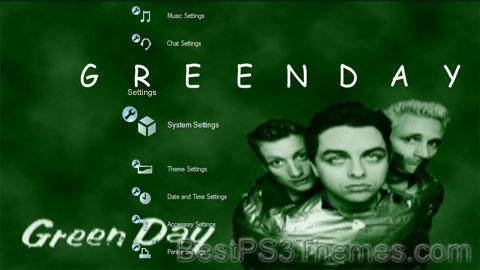
(3 backgrounds, SD only)
Redirect to:
- From a camel case title: This is a redirect from a camel case page name. In the initial versions of Wikipedia, all links had to be "CamelCase", i.e., words that used medial capitals; they are "two-humped" like a Bactrian camel. These are kept as redirects to maintain edit history and to avoid breaking links that may have been made externally.
Iron Maiden
Iron Maiden theme by EvanLocke
Download: IronMaiden.p3t
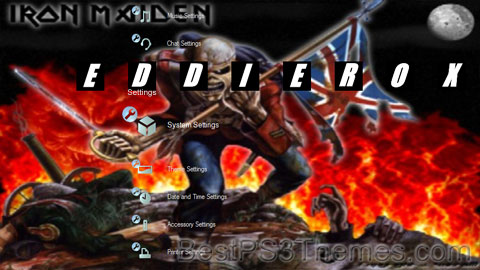
(3 backgrounds, SD only)
Iron Maiden | |
|---|---|
 Top: Steve Harris (L), Dave Murray (R) Middle: Adrian Smith (L), Bruce Dickinson (R) Bottom: Nicko McBrain (L), Janick Gers (R) | |
| Background information | |
| Origin | London, England |
| Genres | Heavy metal[1] |
| Discography | Iron Maiden discography |
| Years active | 1975–present |
| Labels | |
| Members | |
| Past members | |
| Website | ironmaiden |
Iron Maiden are an English heavy metal band formed in Leyton, East London, in 1975 by bassist and primary songwriter Steve Harris. Although fluid in the early years of the band, the line-up for most of the band's history has consisted of Harris, lead vocalist Bruce Dickinson, drummer Nicko McBrain, and guitarists Dave Murray, Adrian Smith and Janick Gers. As pioneers of the new wave of British heavy metal movement, Iron Maiden released a series of UK and US Platinum and Gold albums, including 1980's debut album, 1981's Killers, and 1982's The Number of the Beast – its first album with Bruce Dickinson, who in 1981 replaced Paul Di'Anno as lead singer. The addition of Dickinson was a turning point in their career, establishing them as one of heavy metal's most important bands. The Number of the Beast is among the most popular heavy metal albums of all time, having sold almost 20 million copies worldwide.
After some turbulence in the 1990s, the return of lead vocalist Bruce Dickinson and guitarist Adrian Smith in 1999 saw the band undergo a resurgence in popularity, with a series of new albums and highly successful tours. Their three most recent albums — The Final Frontier (2010), The Book of Souls (2015), and Senjutsu (2021) — have all reached number 1 in more than 25 countries. Iron Maiden have sold over 130 million copies of their albums worldwide and have obtained over 600 certifications. The band is considered to be one of the most influential and revered rock bands of all time. They have received multiple industry awards, including the Grammy and Brit Awards, and are also a permanent part of the Rock and Roll Hall of Fame.
The band have released 41 albums, including 17 studio albums, 13 live albums, four EPs and seven compilations. They have also released 47 singles and 20 video albums, and two video games. Iron Maiden's lyrics cover such topics as history, literature, war, mythology, dark fantasy, science fiction, society and religion. As of October 2019[update], the band have played 2,500 live shows. For over 40 years the band have featured their signature mascot, "Eddie", on the covers of almost all of their releases.
History[edit]
Early years (1975–1978)[edit]

Iron Maiden were formed on Christmas Day, 25 December 1975, by bassist Steve Harris shortly after he left his previous group, Smiler. Harris attributed the band's name to a film adaptation of The Man in the Iron Mask from the novel by Alexandre Dumas, as the title reminded him of the iron maiden torture device.[3] They originally used the name Ash Mountain, but most of the band members preferred the name Iron Maiden. After months of rehearsal, Iron Maiden made their debut at St. Nicks Hall in Poplar on 1 May 1976,[4] before taking up a semi-residency at the Cart and Horses Pub in Maryland, Stratford.[5] The original line-up was short-lived, with vocalist Paul Day being the first to go as, according to Harris, he lacked "energy or charisma on stage".[6] He was replaced by Dennis Wilcock, a Kiss fan who used makeup and fake blood during live performances.[6] Wilcock's friend, guitarist Dave Murray, was invited to join, much to the dismay of the band's guitarists Dave Sullivan and Terry Rance.[7] Their frustration led Harris to temporarily disband Iron Maiden in 1976,[7] though the group reformed soon after with Murray as the sole guitarist. Harris and Murray remain the band's longest-serving members and have performed on all of their releases.

Iron Maiden recruited another guitarist in 1977, Bob Sawyer, who was sacked for embarrassing the band on stage by pretending to play guitar with his teeth.[8] Tension ensued again, causing a rift between Murray and Wilcock, who convinced Harris to fire Murray,[9] as well as original drummer Ron Matthews.[4] A new line-up was put together, including future Cutting Crew member Tony Moore on keyboards, Terry Wapram on guitar and drummer Barry Purkis (better known today as Thunderstick). After a single gig with the band in January 1978, Moore was asked to leave as Harris decided keyboards did not suit the band's sound.[10] Dave Murray rejoined in late March 1978, and when Terry Wapram disapproved he was sacked. A few weeks later, Dennis Wilcock decided to leave Iron Maiden to form his own band, V1, with Wapram, and drummer Barry Purkis also left. Doug Sampson was at Dennis' and Thunderstick's last gig, and joined the band afterwards.
Harris, Murray and Sampson spent the summer and autumn of 1978 rehearsing while they searched for a singer to complete the band's new line-up.[11] A chance meeting at the Red Lion, a pub in Leytonstone, in November 1978 evolved into a successful audition for vocalist Paul Di'Anno.[12] Steve Harris said, "There's sort of a quality in Paul's voice, a raspiness in his voice, or whatever you want to call it, that just gave it this great edge".[13] At this time, Murray would typically act as their sole guitarist, with Harris commenting, "Davey was so good he could do a lot of it on his own. The plan was always to get a second guitarist in, but finding one that could match Davey was really difficult".[14]
Record contract and early releases (1978–1981)[edit]
On New Year's Eve, 1978, Iron Maiden recorded a four-song demo at Spaceward Studios in Cambridge.[15] Hoping the recording would help them secure more gigs,[15] the band gave a copy to Neal Kay, who, at the time, was managing a heavy metal club called "Bandwagon Heavy Metal Soundhouse".[16] After hearing the tape, Kay began playing the demo regularly at the Bandwagon, and one of the songs, "Prowler", eventually went to number 1 in the Soundhouse charts, which were published weekly in Sounds magazine.[17] A copy was also acquired by Rod Smallwood, who soon became the band's manager.[18] As Iron Maiden's popularity increased, they released the demo on their own record label as The Soundhouse Tapes, named after the club.[19] Featuring only three tracks (one song, "Strange World", was excluded as the band were unsatisfied with its production),[20] all 5,000 copies sold out within weeks.[17]
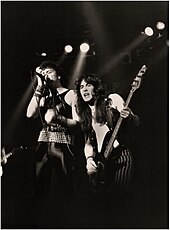
In December 1979, the band secured a major record deal with EMI[21] and asked Dave Murray's childhood friend, Adrian Smith of Urchin, to join the group as their second guitarist.[22] Busy with his own band, Smith declined and Dennis Stratton was hired instead.[23] Shortly after, Doug Sampson left due to health issues and was replaced by ex-Samson drummer Clive Burr at Stratton's suggestion on 26 December 1979.[24] Iron Maiden's first appearance on an EMI album was on the Metal for Muthas compilation (released on 15 February 1980) with two early versions of "Sanctuary" and "Wrathchild".[25] The release led to a tour including several other bands linked with the new wave of British heavy metal movement.[26]
Iron Maiden released their self-titled album in 1980, which debuted at number 4 in the UK Albums Chart.[27] In addition to the title track, the album included other early favourites such as "Running Free", "Transylvania", "Phantom of the Opera" and "Sanctuary" – which was not on the original UK release, but appeared on the US version and subsequent remasters. The band embarked on a headline tour of the UK, before opening for Kiss on their 1980 Unmasked Tour's European leg as well as supporting Judas Priest on select dates. After the Kiss tour, Dennis Stratton was dismissed from the band as a result of creative and personal differences,[28] and was replaced by Smith in October 1980. In December, the band played at the Rainbow Theatre in London, where their first live video was filmed. Live at the Rainbow was released in May 1981, and "Iron Maiden" and "Wrathchild" from this video received heavy rotation on MTV during its first hours on the air as the first metal videos ever.[29][30][31]

In 1981, Iron Maiden released their second studio album, Killers. Although many tracks were written prior to their debut release, it had two new songs: "Prodigal Son" and "Murders in the Rue Morgue"[32] (the latter's title was taken from the short story by Edgar Allan Poe).[33] Unsatisfied with the production on their debut album,[34] the band hired veteran producer Martin Birch,[35] who would continue to work with Iron Maiden until his retirement in 1992.[36] The record was followed by the band's first world tour; their debut performance in the United States, opening for Judas Priest at The Aladdin Casino in Las Vegas. Killers marked the band's USA album charts debut, reaching number 78 on the Billboard 200,[37] and they booked 132 shows to promote the album, including their first concert in Belgrade, Yugoslavia.[38] During the summer, Iron Maiden played several festivals in Europe, including at the Golden Summernights 1981 festivals at Zeppelinfeld in Nuremberg in front of 100,000 people.[30]
Success (1981–1985)[edit]

By 1981, Paul Di'Anno was demonstrating increasingly erratic behaviour, particularly due to his drug usage,[4] about which Di'Anno comments, "It wasn't just that I was snorting a bit of coke, though; I was just going for it non-stop, 24 hours a day, every day ... the band had commitments piling up that went on for months, years, and I just couldn't see my way to the end of it. I knew I'd never last the whole tour. It was too much".[39] Di'Anno was dismissed following the Killer World Tour,[40] and the band had already selected his replacement.[41] After a meeting with Rod Smallwood at the Reading Festival,[42] Bruce Dickinson, formerly of Samson, auditioned for Iron Maiden in September 1981 and was immediately hired.[41] The following month, Dickinson went out on the road with the band on a small headlining tour in Italy and a one-off show at the Rainbow Theatre in the UK.[40] For the last show, and in anticipation of their forthcoming album, the band played "Children of the Damned" and "22 Acacia Avenue", introducing fans to their new material.[43]
In 1982, Iron Maiden released their third studio album, The Number of the Beast, which became the band's first number 1 record on the UK Albums Chart,[44] was a Top 10 hit in many other countries and reached number 33 on the Billboard 200.[37][45] At the time, Dickinson was in the midst of legal difficulties with Samson's management and was not permitted to add his name to any of the songwriting credits, although he still made what he described as a "moral contribution" to "Children of the Damned", "The Prisoner" and "Run to the Hills".[46] The band embarked on a world tour, dubbed The Beast on the Road, with shows in North America, Japan, Australia and Europe, including a headline appearance for 40,000 people at the Reading Festival. Iron Maiden played 188 shows in 10 months.[30] The Beast on the Road's US leg proved controversial when an American conservative political lobbying group claimed Iron Maiden were Satanic because of the new album's title track and "demonic" cover art,[45] and a group of Christian activists destroyed Iron Maiden records in protest.[47] Dickinson later said the band treated this as "silliness"[48] and the demonstrations in fact gave them "loads of publicity".[4] The Number of the Beast sold 2.5 million copies in its first year, 14 million by 2010, and 20 million by 2022.[49][50][51][52]

In December 1982, drummer Clive Burr was fired from the band and replaced by Nicko McBrain, who previously played for Trust.[53] Although Harris said the dismissal took place because his live performances were affected by offstage activities,[54] Burr later claimed he was unfairly ousted from the band.[55] The band then recorded the first of three consecutive albums at Compass Point Studios in the Bahamas.[56] In 1983, they released their fourth studio album, Piece of Mind, which reached the number 3 spot in the UK[57] and number 14 on the Billboard 200.[37] Piece of Mind features the singles "The Trooper" and "Flight of Icarus", the latter being one of the band's few songs to gain substantial airplay in the US.[58] Iron Maiden played 147 concerts in Europe and North America as a part of the World Piece Tour. This was also their first major North American tour as headliners, selling out Madison Square Garden with a crowd of 20,000.[30][59]
After the success of Piece of Mind and its supporting tour, the band released their fifth studio album, Powerslave, on 9 September 1984. The album features the singles "2 Minutes to Midnight" and "Aces High", the title track, and "Rime of the Ancient Mariner" (based on Samuel Taylor Coleridge's poem of the same name).[60] Powerslave was another chart success, reaching number 12 on the Billboard 200[37] and eventually number 1 in the UK.[61][62][63] Band's fifth studio album sold over 4 million copies in its first year after the premiere.[64] The tour following the album, called World Slavery Tour, was the band's largest to date with 193 shows in 28 countries over 13 months,[60] playing to an estimated 3,500,000 people.[65][66] Many shows were played back to back in the same city, such as in Long Beach, California, where the band played four consecutive concerts at Long Beach Arena for a combined audience of 54,000 fans.[67] Iron Maiden also made their debut appearance in South America, where they co-headlined the Rock in Rio festival with Queen for an audience estimated at 350,000–500,000 people.[68][69] The tour started in August 1984 with five shows in Poland. Iron Maiden were the first Western artists to bring full-scale production behind the Iron Curtain. The band's third official video, entitled Behind the Iron Curtain, was released in October 1984. The World Slavery Tour documentary brought footage of the band touring Eastern Europe in 1984, performing shows in the countries visited, Behind the Iron Curtain was the first documentary ever published by a Western artist that showed them touring the countries of Eastern Bloc. The documentary movie was broadcast by MTV and local TV stations around the world.[70]
The tour was physically gruelling for the band, who demanded six months off when it ended (although this was later reduced to four months).[71] This was the first substantial touring break in the group's history, including the cancellation of a proposed supporting tour for the new live album,[72] with Bruce Dickinson threatening to quit unless the tour ended.[73] In October 1985, Iron Maiden released the double live album and home video, Live After Death. A critical and commercial success, it peaked at number 19 on the Billboard 200[37] and number 2 in the UK.[74] The album was recorded at Long Beach Arena and also features additional tracks from four nights at London's Hammersmith Apollo.[75][76] In November 1985, Iron Maiden were named the best rock and metal band in the world and awarded at Public Choice International.[77]
Experimentation (1986–1989)[edit]
Returning from their time off, the band added different musical elements to their 1986 studio album, Somewhere in Time. These focused on synthesised bass and guitars to add textures and layers to the sound.[78] The release performed well across the world, particularly the single "Wasted Years", but included no writing credits from Dickinson, whose material was rejected by the rest of the band.[79] The album was the band's biggest American chart success to date, reaching number 11 on the Billboard 200[37] and number 2 in the UK charts.[74][80] The Somewhere on Tour was also a success. The band played 157 shows for over two and a half million fans, including eighty-one shows in North America. Once again, Iron Maiden visited Poland, Hungary and Yugoslavia to play for tens of thousands of fans in each country.[81] The experimentation evident on Somewhere in Time continued on their next album, Seventh Son of a Seventh Son, which was released in 1988. A concept album recorded at Musicland Studios in Munich[82] and based on the 1987 novel Seventh Son by Orson Scott Card,[83] it was the band's first record to include keyboards, which were performed by Harris and Smith.[83] Dickinson's enthusiasm was also renewed as his ideas were accepted for this album.[84] Another popular release, it became Iron Maiden's second album to hit number 1 in the UK charts
Thousand Foot Krutch theme by Jabyaeye Download: TFK.p3t
Thousand Foot Krutch (often abbreviated TFK) is a Canadian Christian rock band formed in Peterborough, Ontario, in 1995.[5][6] The band has released ten studio albums, two live albums, and three remix albums. The core members consist of founding member Trevor McNevan (vocals, guitar), Steve Augustine (drums), and Joel Bruyere (bass, backing vocals).
Since forming, Thousand Foot Krutch sold over 1.1 million albums and reached No. 1 on the Billboard Hard Rock Albums Chart twice.[7][8][9]
Trevor McNevan formed the band in his hometown of Peterborough, Ontario, a city northeast of Toronto, with his childhood friend Joel Bruyere and drummer Steve Augustine. McNevan's first band was Oddball, and featured Dave Smith on guitar, Tim Baxter on bass and McNevan's good friend, Three Days Grace's Neil Sanderson, on drums. Oddball recorded only one album, Shutterbug, which was released in 1995. The band's name was conceived by McNevan "symbolizing the point in our lives that we realize we can't make it on our own strength".[10] He has written and released seven albums with Thousand Foot Krutch to date and another four with his side project FM Static.
Shutterbug was released by Trevor McNevan in 1995 under the band name Oddball. McNevan had friends Dave Smith (guitar), Tim Baxter (bass) and Neil Sanderson (drums), play on the album. There were 27 songs on the album, the first half rock, the second half hip-hop. McNevan recorded it at Barry Haggarty's studio in his home town of Peterborough, Ontario, Canada. He worked at McDonald's and other jobs to pay for the studio time. The song "Lift It" first appeared here and was later re-recorded for Thousand Foot Krutch's first release, That's What People Do, and appeared again on Set It Off.[11][12]
That's What People Do was written the year McNevan started TFK in 1997. It was released independently in 1998 and is out of print. It sold over 5,000 copies. TFK climbed the ladder of local notoriety throughout Ontario and abroad. Reaching the ears of Ontario commercial radio, CKWF 101.5 FM in their home town of Peterborough added "Rhyme Animal", the band's first single from their independent recording, to their rotation. It clicked with listeners and within two months ended up being one of the five most requested songs of the year.
In 1999, TFK was chosen by 7 Ball Magazine as one of the top 25 bands in North America. They were also awarded "Best Indie Recording" and McNevan awarded "Vocalist of the Year" by the readers of The Wire Magazine. They were then awarded "Band of the Year" at the 2000 Wire Awards. They were also voted as the No. 1 band of the millennium on 100.3 FM in Barrie, Ontario.[citation needed]
Set It Off was released on November 14, 2000. It was the group's first indie label release. Though the sound of the album was distinct in its heavily hip-hop influenced nu metal, a few songs from the record (including "Puppet" and "Supafly") impacted at both secular and Christian radio.[citation needed] The band toured it extensively across North America and ended up garnering much label attention by selling 85,000 copies of the indie release out of their van.[13] The band also printed a limited edition, "pre-release" version of Set It Off sold only at their release party at The Gordon Best Theatre in Peterborough, Ontario for their local fans. TFK toured with Finger Eleven, Econoline Crush, Treble Charger, the Tea Party, Matthew Good Band, Gob, Sum 41 and others. Three Days Grace, which was a cover band at that time, was TFK's regular support act.[citation needed] McNevan helped with recordings of Three Days Grace's demo album. He is also featured on their song "This Movie" from this album. Around this same time, Dave Smith left the group, making McNevan the only original member. Smith was replaced with Myke Harrison, who parted ways about a year later. After Dave Smith's departure, McNevan began writing all the guitar lines and the band has used a live guitar player instead of officially replacing him.
Track seven from this album, "Unbelievable" – a cover of the EMF song of the same name – appeared on the soundtrack for the 2010 film Just Wright.[14]
In 2003, the band signed with Seattle-based Tooth & Nail Records and released their second full-length album, Phenomenon. Though something of a departure from the rap-heavy sound of Set it Off, Phenomenon still relied on McNevan's rhythmic vocals, albeit with a solid modern hard rock sound. It was well received, and spawned four radio singles, including "Rawkfist". The album sold 200,000 units[15][16] making it one of the best-selling albums in Tooth & Nail's history. They continued this success with the 2004 re-release of Set it Off through Tooth & Nail, allowing for a larger print run and adding six songs, including five from "That's What People Do", and one new song "Everyone Like Me", produced by Gavin Brown.
At this time, McNevan and Augustine started a side band called FM Static, which differentiated from TFK with its pop-punk/pop-rock sound, with the overall tone being more lighthearted. FM Static scored numerous No. 1 songs, including their songs "Crazy Mary", and "Something to Believe In". In 2004, TFK toured with Kutless on the "Sea of Faces" tour alongside Falling Up and as FM Static.
On July 19, 2005, they released their third full-length album The Art of Breaking, produced by Arnold Lanni. The album makes almost a complete break from the nu metal sound of Phenomenon, focusing more on heavy elements. It is the first album to feature short guitar solos. "Move" peaked at No. 16 on the Billboard Mainstream Rock chart early 2006.[citation needed] Other singles included "Absolute" and "Breathe You In", which was released to alternative radio and was one of the band's first slower songs. During this time the band toured extensively.
In 2006, McNevan became involved with TobyMac and helped him write the song "Ignition" found on Portable Sounds. The song has been used in media placements including Monday Night Football and NASCAR. Because of this, in the early 2007, the band was part of the TobyMac Portable Sounds tour. The tour was such a success that Toby asked them to do the year-end tour as well.[17]
After working in the studio with producer Ken Andrews they released The Flame in All of Us on September 18, 2007, with a move to a more mainstream rock sound, with some heavy influences from bands such as fellow Canadian artists Our Lady Peace and other metal bands of the time. The album includes the singles "Falls Apart", "What do we Know?", "Favorite Disease" and "The Flame in All of Us". On January 20, 2008, "The Flame in All of Us" became the 1000th song to make it on the ChristianRock.Net Top 30 Chart. The next tour was in early 2008 with Skillet and Decyfer Down. After a lengthy summer playing festivals and one-offs, they were included in the first Creation Festival: The Tour that consisted of nine bands: Kutless, Pillar, KJ-52, Fireflight, Worth Dying For, Run Kid Run, Esterlyn, Capital Lights and themselves. They were asked to headline three tour dates, but declined.[18] They also recorded the Christmas song "Jingle Bell Rawk" for the X Christmas compilation Christmas album, compiled by Tooth & Nail Records.[citation needed]
For Welcome to the Masquerade, the band reunited with Aaron Sprinkle to co-produce this album, with Emery's Matt Carter assisting and Randy Staub mixing. The song "Fire It Up" was included in video games such as EA Sports NHL 10, and in the G.I. Joe: The Rise of Cobra film trailer.[19] The album was released on September 8, 2009 and peaked at No. 35 on the Billboard 200.[20] In mid-2009, McNevan underwent emergency surgery on his appendix, causing the band to cancel at Creation West Festival.[21] He returned to play shows a week later. The band appeared at other festivals that year, including their debut appearance at Soulfest. They announced a year-end tour to support the new album. They also appeared on Creation Festival: The Tour again, this time with Jars of Clay, Audio Unplugged, B.Reith, FM Static and This Beautiful Republic.[22] They were later involved with a Christmas holiday show with Thirty Seconds to Mars, Flyleaf, After Midnight Project and The Veer Union. On September 8, 2009, TFK's three albums, Phenomenon, The Art of Breaking, and The Flame in All of Us were re-released as a three-CD set: Deja Vu: The Thousand Foot Krutch Anthology.[23] They toured with Breaking Benjamin, Chevelle and Red in March 2010.
In a concert video posted on February 1, 2010, the band was seen with a new guitarist, Ty Dietzler, who replaced Nick Baumhardt as the touring guitarist. He has also played rhythm guitar for the Letter Black.[24] In the first week of April 2010, "Fire it Up" was released in the Rock Band music store to be used in Rock Band 2. On April 19, The Detroit Red Wings used "The Invitation" and "Welcome to the Masquerade" during the pre-game introduction.[25] On May 11, 2010, McNevan announced on his personal Facebook page: "We [TFK] covered "The Heat Miser Song" from the old classic Christmas special, gonna do one with FM too, but that's a surprise..." referring to their upcoming appearance on the album X-Christmas 2 by Tooth & Nail Records. He also stated that a live DVD was planned for the very near future and was to be recorded at the May 28 at YC Alberta event at Rexall Place.[26] During the 2010 NBA playoffs, "Move" was used by ABC.[citation needed] In 2010, TFK performed at Creation Festival: The Tour Presents the Welcome to the Masquerade Fall Tour. They headlined the tour, which also featured Disciple and Ivoryline,[27] with Decyfer Down replacing Disciple during the last week of the tour.[22] The band also stated that they started writing tracks for a new record.[citation needed]
In January 2011 TFK joined the Rock and Worship Roadshow national tour headlined by MercyMe.[28] On March 2, 2011, Dietzler announced that he would be leaving the band at the end of the month.[29] The band searched for a replacement guitarist,[30] but on March 30, 2011 the band announced that Dietzler would remain with the band, and cancelled the search for a replacement.[31] On June 7, 2011, they released a live album and DVD: Live at the Masquerade.[32] On September 10, 2011, they headlined at the First Love Festival in Buena Vista, New Jersey along with Decyfer Down, Remedy Drive, Addison Road, Dave Pettigrew and Compelled.[33]
The End Is Where We Begin was released on April 17, 2012.[34]
On November 29, 2011, they announced that they would be leaving Tooth & Nail Records to release The End Is Where We Begin independently[35] and turned to crowdfunding to release the album.[36] The song "War of Change" was made available for free download in early December.[37]
"War of Change" was the theme song for the 2012 edition of WWE Over the Limit.[38]
On October 15, 2013, the band released Made in Canada: The 1998-2010 Collection, a fourteen-track collection featuring two new songs, "Searchlight" and "Complicate You".[39]
The band launched another crowdfunding campaign to raise funds for OXYGEN:INHALE in May 2014.[40] The first single from the album, "Born This Way", was released on July 22.[41] The second single, "Untraveled Road", was released on August 6 on YouTube.[42]
For live performances in September and October 2015, Joshua Sturm, husband of former Flyleaf vocalist Lacey Sturm, filled-in for Joel Bruyere who had been hospitalized due to a collapsed lung.[43]
Three singles were released in advance of the release of their follow-up, Exhale: "Born Again" on December 11, 2015,[44] "Incomplete" on February 1, 2016,[45] and "Running with Giants" on February 25, 2016.[46] The album itself was released on June 17, 2016 and debuted at No. 34 on the US Billboard 200, selling 14,000 copies.[47] On September 15, 2017, The band released a second live album, Untraveled Roads, as a CD and DVD combo pack.[48] After releasing the live album in 2017, TFK entered an indefinite hiatus to focus more on their families, with Trevor McNevan working on a hip-hop project in the meantime.[49][50][51]
In 2023, the band announced their return from hiatus and their first new project since 2017, which is set to be a newly re-recorded version of their 2012 album The End Is Where We Begin entitled "The End Is Where We Begin: Reignited" while collaborating with several of their musical peers, releasing the single "War Of Change" with Adelitas Way in July 2023, "Down" with New Medicine in August 2023, "So Far Gone" with Art of Dying in October 2023 and "I Get Wicked" with Red in March 2024, "Be Somebody" with Citizen Soldier in April 2024.[52][53]
Former[56]
Touring
Session
Timeline Gospel Music Association Canada Covenant Awards
Thousand Foot Krutch
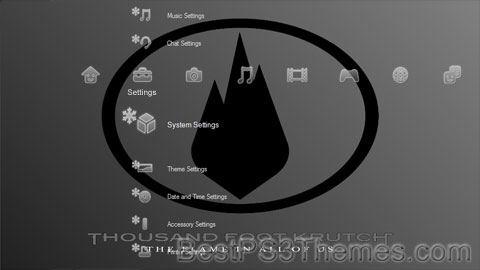
(1 background)

Background information Also known as Oddball (1995–1996) Origin Peterborough, Ontario, Canada Genres Years active 1995–present (hiatus 2017–2023) Labels Members
Past members
Website thousandfootkrutch Background[edit]
Early years[edit]
Tooth & Nail years[edit]

Post-label, hiatus and return[edit]

Members[edit]

Discography[edit]
Awards and recognition[edit]
![]()
Year
Award
Result
2005
Artist of the Year
Won
Group of the Year
Won
Modern Rock Album of the Year (The Art of Breaking)
Won
2006
Video of the Year ("Move")
Won
2008
Group of the Year
Nominated
Hard Music Album of the Year (The Flame in All of Us)
Nominated
Hard Music Song of the Year ("Falls Apart")
Nominated
2010
Rock Album of the Year (Welcome to the Masquerade)
Won
Rock Song of the Year ("Forward Motion")
Won
Hard Music Song of the Year ("Bring Me to Life")
Won
Year
Award
Result
2004
Rock Album of the Year (Phenomenon)
Nominated
2005
Rock Album of the Year (Set It Off)
Nominated
2006
Rock Album of the Year (The Art of Breaking)
Nominated
Short Form Music Video of the Year ("Move")
Nominated
2008
Short Form Music Video of the Year ("Falls Apart")
Nominated
2010
Rock Album of the Year (Welcome to the Masquerade)
Nominated
Rock Song of the Year ("Bring Me to Life")
Nominated
2013
Rock Album of the Year (The End Is Where We Begin)
Nominated



